It’s also all about the design of the whole space – how well it complements the rest of your property. If you’re new to gardening, you may find that there are lots of decisions to make. Here are some tips on how to get started.
1. Choose Your Planting Scheme
The first decision you’ll have to make is whether you want to plant in rows, beds, or groups. This choice will determine what type of plants you should grow. If you choose a bed plan, consider planting vegetables and herbs together. You could even mix up some flowers with your veggies. For maximum variety, choose plants with slightly different shapes and heights, such as strawberries or tomatoes.
For those who like to be more organized, you can group each vegetable into its small section, so they don’t interfere with others. When growing plants in this way, it’s best to keep them at least a foot apart from another.
If you prefer a row-style plan, you can try using edging or trellises. These are ideal if you want to create a border around your garden but aren’t sure about having a lot of space between them.
When choosing which plants to grow, remember that they’ll need plenty of water and sunlight to flourish. So look out for plants that require full sun and moist soil while avoiding those that need shade and dry conditions.
2. Prepare The Ground
Preparing the ground before planting anything is essential if you want your new plants to thrive. Dig out any weeds, and remove any stones or roots. Then dig a hole where you’d like to plant, and add compost or manure to the hole, depending on which plants you’re planting.
As you prepare the area, think about what type of drainage system you want to use. There are two main options for drainage: natural and artificial. Natural systems involve mulching the surface, which helps prevent the soil from drying out. Artificial systems include drains, gutters, and pipes.
3. Install Trellis or Pergola Support Systems
Depending on the plants you will grow, you can install trellises or pergolas in various ways. One way is to build a structure that supports only one or two plants. An example would be a single trellis used to support runner beans. Another option is to create a framework that holds several varieties of plants. This is often done using metal poles with netting attached to them.
Another option is to use wooden structures, such as arches, pergolas, or latticework. They allow you to grow a wide range of plants because you can plant underneath them instead of above them. However, these can take up a lot of room and look untidy.
4. Create A Waterproof Foundation
You’ll need to lay down a waterproof foundation to ensure your new garden stays green. This action involves lining the base of your structure with waterproof material, such as concrete, gravel, or bricks.
If you’re unsure how to lay this foundation, hire a professional gardener to help you. They will be able to advise you on the right materials to use and will probably recommend that you lay down an extra layer of mortar at the bottom of the structure to stop the water from getting through.
5. Add Decorative Features To Enhance Design
Once your foundation is laid down, you can add decorative features. Try hanging pots, baskets, or even statues from the structure. Or you could put up a bird feeder or climbing rose, for example. These things will provide interesting color and height contrast to your garden and make you feel good every time you visit.
You can even hang clotheslines from the structure if you want to give yourself some privacy. If you want to keep things simple, however, you can try using a few trellises placed a few feet apart to create your hedge.
Do you need to hire a dedicated Landscape contractor to help you execute the idea?
Landscape contractors are experts at designing and building beautiful landscapes, but many don’t take the time to design a garden that requires little or no maintenance. It doesn’t have to be this way. With these tips, you can easily create your own low-maintenance, beautifully designed landscape.
If you’re not sure where to start when it comes to landscaping, there is plenty of help online. Check out our list of references to get started.
Once you’ve decided to landscape your yard, you’ll want to choose a type of plant that will thrive in your climate without much care. While there isn’t a one-size fits all solution, here are some guidelines to help you make an informed decision.
7. Time irrigation systems to reduce the need for lawn maintenance
When choosing plants for your yard, think about what watering system you’d like to install. If possible, consider installing a drip irrigation system. The technology works by slowly releasing water from small emitters (sprinklers) placed throughout the plantings — much like raindrops fall through the air. Drip systems usually cost more than traditional sprinkler systems, but they require less maintenance and use significantly less water per square foot.
Another option is to install a soaker hose — which allows water to soak into the ground rather than simply being sprayed over the surface. This method is most effective if you live in a hot, arid climate. A combination of both methods might work best if you live in a moderate climate.
You’ll also want to consider if you’re going to include trees and shrubbery in your yard. Trees and shrubs add beauty and value to any home but require regular watering and pruning. If you aren’t willing or able to keep up with the upkeep of your trees and shrubs, consider opting for drought-tolerant species such as pines and eucalyptus.
On the other hand, plants that prefer dry conditions, such as cacti, succulents, and desert plants, look great when left unattended. These types of plants don’t require much maintenance at all.
8. Opt for decorative grasses
Grasses play a big role in a well-designed landscape. They offer a soft, natural texture that can soften the hard lines between walkways and driveways. And plenty of varieties of grass are available in all shapes, sizes, and colors.
For example, you can choose green, blue, purple, yellow, red, white, and even black grasses. Plus, grasses grow tall or short, depending on the available space. Some grasses have sharp edges, and others don’t. You can opt for grasses with blades that spread wide or narrow to fit the shape of your property. Even ornamental grasses grow in a bonsai style, perfect for small spaces in tight corners.
If you love the look of native grass, consider planting it instead of turfgrass. Native grasses are easy to maintain, and they’re beautiful, too! These grasses include buffalo grass, blue grama, and prairie dropseed.
9. Consider xeriscaping
Xeriscaped yards are typically low-maintenance. The term “xeriscape” was coined by Dr. William Leff in his book Xeriscape Gardening: A Guide to Sustainable Design. He describes xeriscapes as “landscapes designed to perform with minimum input.”
A common misconception about xeriscaping is that it means removing all vegetation. That’s not the case. Many xeriscapes still contain some plants, just fewer than those in conventional lawns. Xeriscaping is about using plants that require very little water and fertilizer.
This means you won’t rely on chemical fertilizers and pesticides to keep your garden looking lush and healthy. When done right, xeriscaping looks beautiful and adds value to your home.
Another benefit of xeriscaping is its lower carbon footprint. Many people believe that a xeriscape is greener because it uses less water and energy to maintain. Unfortunately, according to some research, xeriscaping has a higher carbon footprint than conventional lawns because the chemicals used to treat conventional lawns are released into the environment.
In addition, xeriscapes require less water during drought because their roots store moisture in the soil. So if you live in an area prone to long droughts, xeriscaping may be a better choice.
10. Include mulch
Mulching is another important part of creating a low-maintenance landscape. Mulch covers up bare spots and keeps weeds in check. It also helps prevent erosion and retains moisture. While there are many options, including wood chips, leaves, straw, and peat moss, you should never forget to pick something that suits your needs and budget.
Mulch also adds character to a yard. For example, mulched pathways and flower beds look nicer than paths and beds that are plain and simple.
11. Grow perennials
Perennial gardens are popular because they require minimal maintenance and last for years. This system makes them ideal for creating a low-maintenance landscape. Perennials grow back year after year and are resilient enough to handle the stress of extreme temperatures.
They also provide color and interest all season long. Consider planting daisies, hostas, daylilies, geraniums, foxgloves, irises, phlox, sedums, and sweetpeas. You can plant perennials in various ways: single plants along the border of your yard, mixed along the perimeter, or grouped together in large drifts.
12. Look into synthetic grass
Many homeowners find themselves wishing they had a lush, green lawn. But what if you could enjoy a lush, green lawn without mowing it? Synthetic grass may be the answer. It’s made from recycled plastic bottles and contains no harmful chemicals. It’s durable, low maintenance, and looks beautiful.
Synthetic grass takes advantage of a technique called tufting, which involves laying down multiple layers of material to create a realistic-looking lawn. This technique is similar to carpeting and rugs, which look great on floors but can quickly become worn and dirty.
Synthetic grass doesn’t wear out as real grass does. It’s resistant to mildew, mold, and insects. And because it’s made of recycled materials, you’ll save on replacement costs.
13. Decide on low-maintenance plants
Before planting your new garden, decide what you’d like to see. Do you want a mix of flowers, herbs, fruits, vegetables, and trees? Do you prefer a few rows of perennials, annuals, or bulbs? Are you planning to include a patio or deck? Once you know what you want, you’ll be able to choose plants that suit your needs.
There are many low-maintenance plants out there. Choose plants that will thrive in your climate and that you’re comfortable caring for. They should also fit in aesthetically with the overall design of your yard.
14. Consider purchasing a container garden
Container gardening is a great way to create a beautiful garden without spending a lot of money upfront. With containers, you can place almost anything you want in a pot or urn. You can choose flowers, veggies, herbs, fruits, and exotic plants.
Containers also give you flexibility when it comes to placement. You can put them anywhere you want — besides the front door or near the kitchen window. Containers are also an excellent way to add height and drama to your design.
15. Employ concrete pavers.
Concrete pavers are another inexpensive way to upgrade your landscape. Concrete pavers range in size and shape, so they’re an excellent choice if you want a specific look in your yard. They come in various styles, and you can create your unique pattern with them.
And while concrete pavers are relatively inexpensive, they last forever. They can withstand heavy traffic and harsh weather and never need replacing.
While several options are available, concrete pavers are perfect for your low-maintenance landscape.
17. Maintain And Enjoy!
Now that you know how to create a beautiful garden, you’ll need to maintain it once it’s finished. Maintaining means keeping everything clean and tidy and ensuring it doesn’t become overgrown.
One of the easiest things to do is to prune back some of the plants once a year. As you become more experienced, you’ll learn when to cut back certain plants and when to leave them alone. For example, some plants are considered climbers and grow upwards rather than downwards. Pruning these kinds of plants allows them to grow freely without needing to be tied back.
In addition, you’ll need to check that your watering system is working properly. If you have a hosepipe, ensure it isn’t leaking anywhere. Also, if you have a sprinkler system, check to see that the heads are working correctly. Once you’ve checked all of this, you can enjoy your new garden.
Finally, why not build a greenhouse if you’re looking for something more unusual? This decision will give you a place to store your plants during the winter and create a mini-greenhouse perfect for growing tender seeds.
If you enjoyed reading this article, you’d love our next video about ten ideas for maintaining your garden landscape without the high attention and cost required.
10 Low Maintenance Garden Landscaping Ideas Video:
Relaxing in the garden while enjoying the spectacular landscaping can help you unwind. The cool breeze that may lull you to sleep is what makes it better.
Unfortunately, that serene feeling does not come by itself. If you want this tranquility, you have to earn it by taking care of your garden, which is not that easy, especially if you do not have a green thumb.
Does it mean you cannot have a beautiful garden in your house? Of course not! Check out these ten low-maintenance garden landscaping ideas that will give you the relaxing ambiance you have longed for without the hassle.
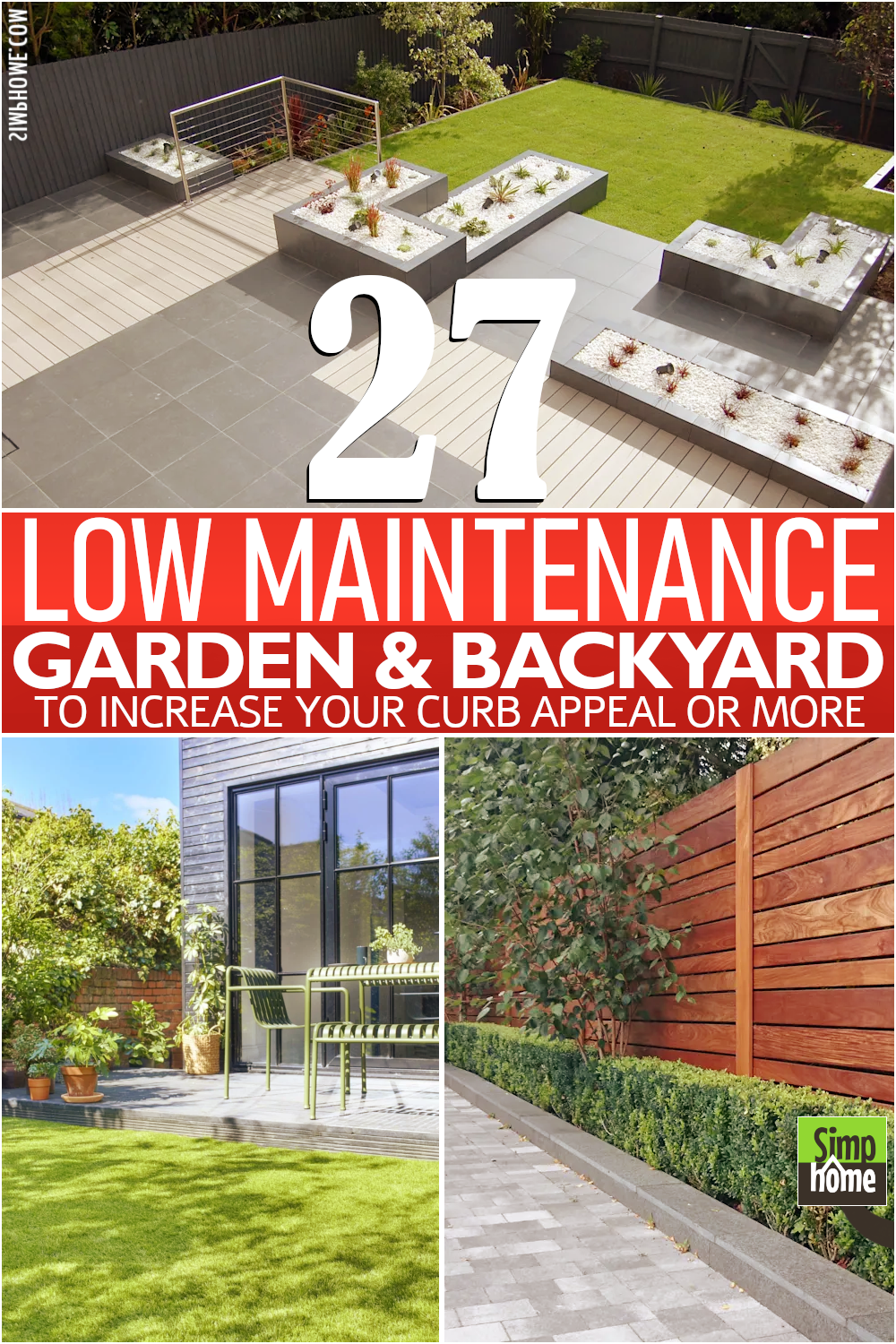
10. Expand the Hardscape
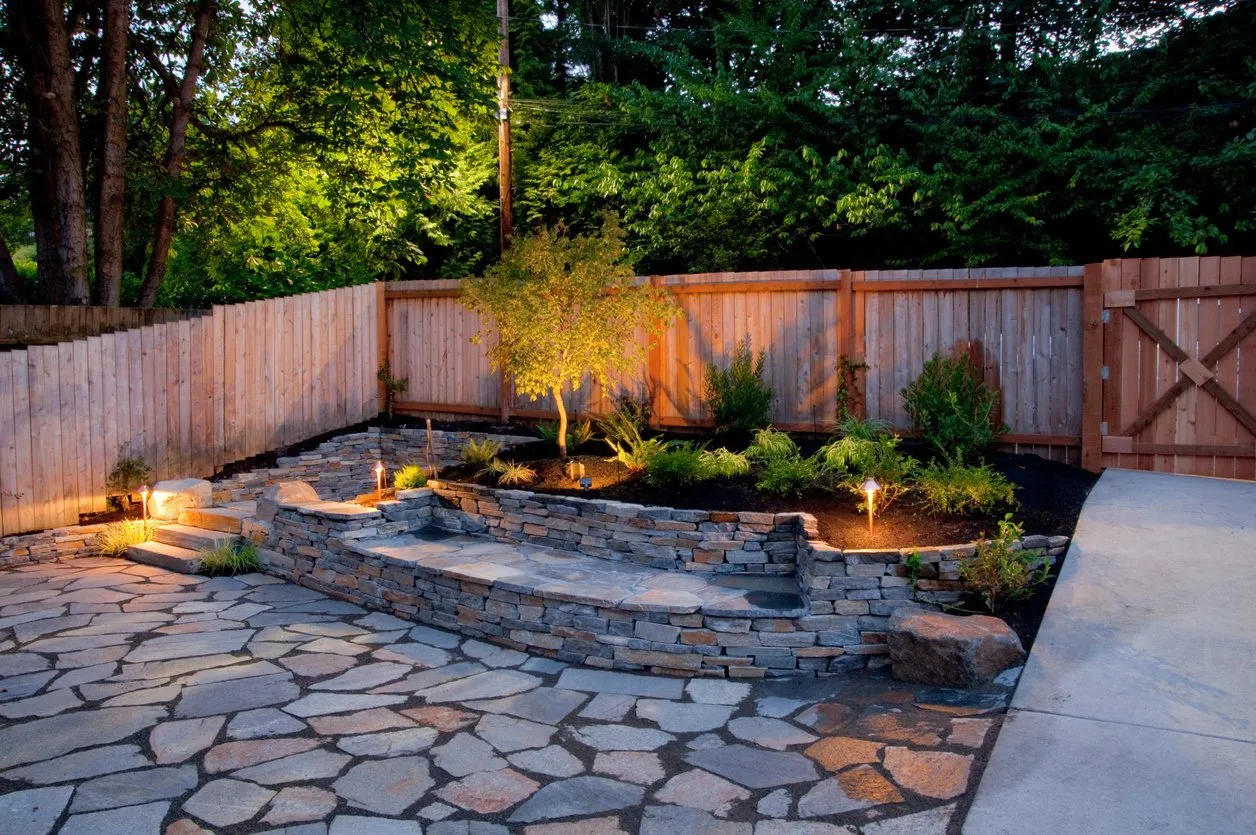 A garden with a lush, green lawn is everyone’s favorite. However, it would be best if you mowed it regularly to get the best look, which takes a lot of time. It is no picnic.
A garden with a lush, green lawn is everyone’s favorite. However, it would be best if you mowed it regularly to get the best look, which takes a lot of time. It is no picnic.
If your ultimate goal is to get a nice place to hang out outdoors, you can always forgo the lawn and swap it for a more hardscape.
When you expand your hardscape, you will not need to do the regular work to keep the top-notch shape of your lawn. It means you will have more time to kick back and relax without worrying about the veritable jungle that conquers your yard.
Instead of a lawn, you can pave, gravel, or deck your garden for a hassle-free beauty. Besides, pavers and concrete provide a durable surface that can prevent you from stepping into the mud. More importantly, they do not need weeding or watering.
9. Prefer Shrubs to Flowerbeds
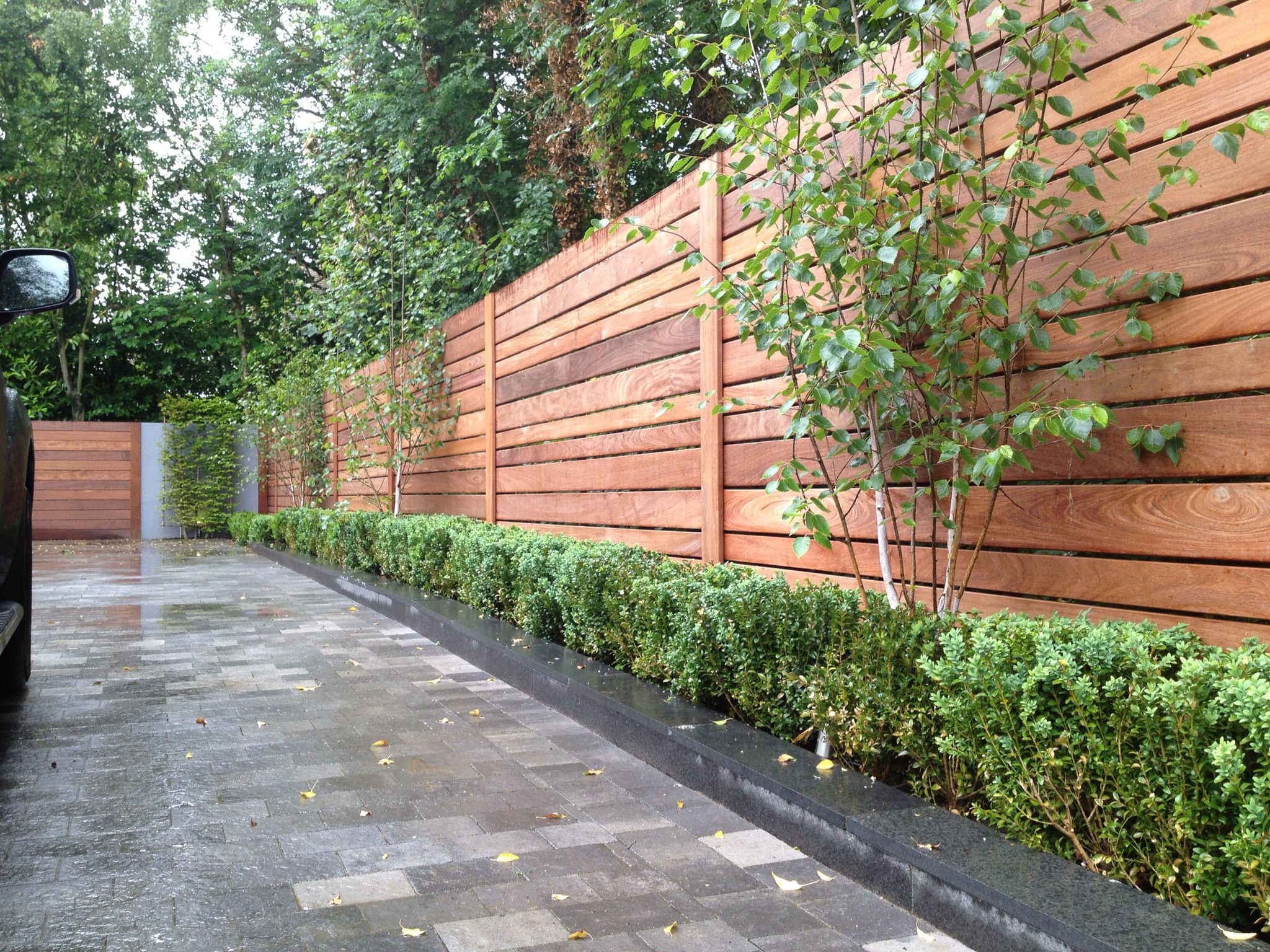 People usually use flowerbeds to border a pathway or patio. Since they come in various colors and shapes, they are beautiful and pleasing. Besides, they can attract butterflies, birds, and bees, which may enhance the serene look of your garden.
People usually use flowerbeds to border a pathway or patio. Since they come in various colors and shapes, they are beautiful and pleasing. Besides, they can attract butterflies, birds, and bees, which may enhance the serene look of your garden.
Unfortunately, you need to go the extra mile to create such spectacular landscaping. You need to water and prune the flowers regularly, which is not a good idea for a busy person.
Instead of growing flowerbeds that require regular maintenance, you can opt for shrubs and hedges.
Boxwood is a favorite one that may meet your need.
Although boxwood is not as colorful as flowers, it can make a pretty good border. Besides, it will complement your modern house immensely.
If you want to incorporate more colors without the hassle, you can go for flowering shrubs, such as hydrangeas and mahonia.
8. Grow Unfussy Plants
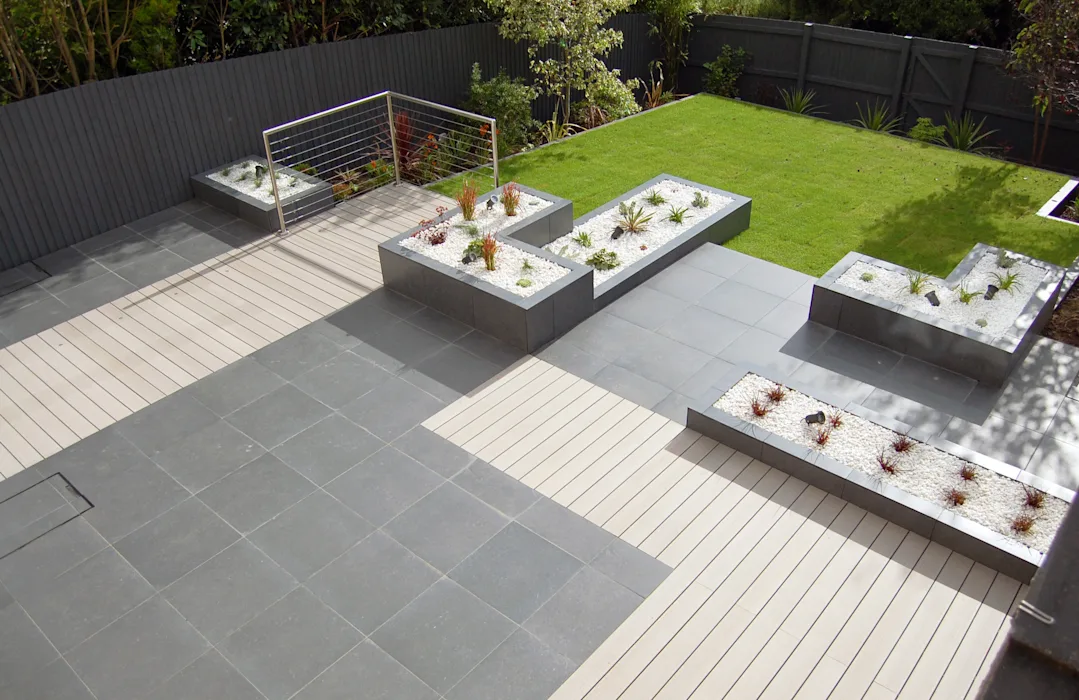 Gardens have always been synonymous with plants. You can expand your hardscape as much as possible, but you will find that something is missing if you forgo the plants whatsoever.
Gardens have always been synonymous with plants. You can expand your hardscape as much as possible, but you will find that something is missing if you forgo the plants whatsoever.
Growing some plants is not always a bad idea when creating a low-maintenance garden. You can still earn beauty without arduousness by investing in no-fuss plants.
Succulents are always the go-to plants of many low-maintenance gardens because they are drought tolerant and come in various shapes and colors.
If you want to grow some flowers to add pops of colors and a striking look to your garden effortlessly, you can try Cone Flowers, Peonies, and Hostas.
7. Invest in Comfortable Seating
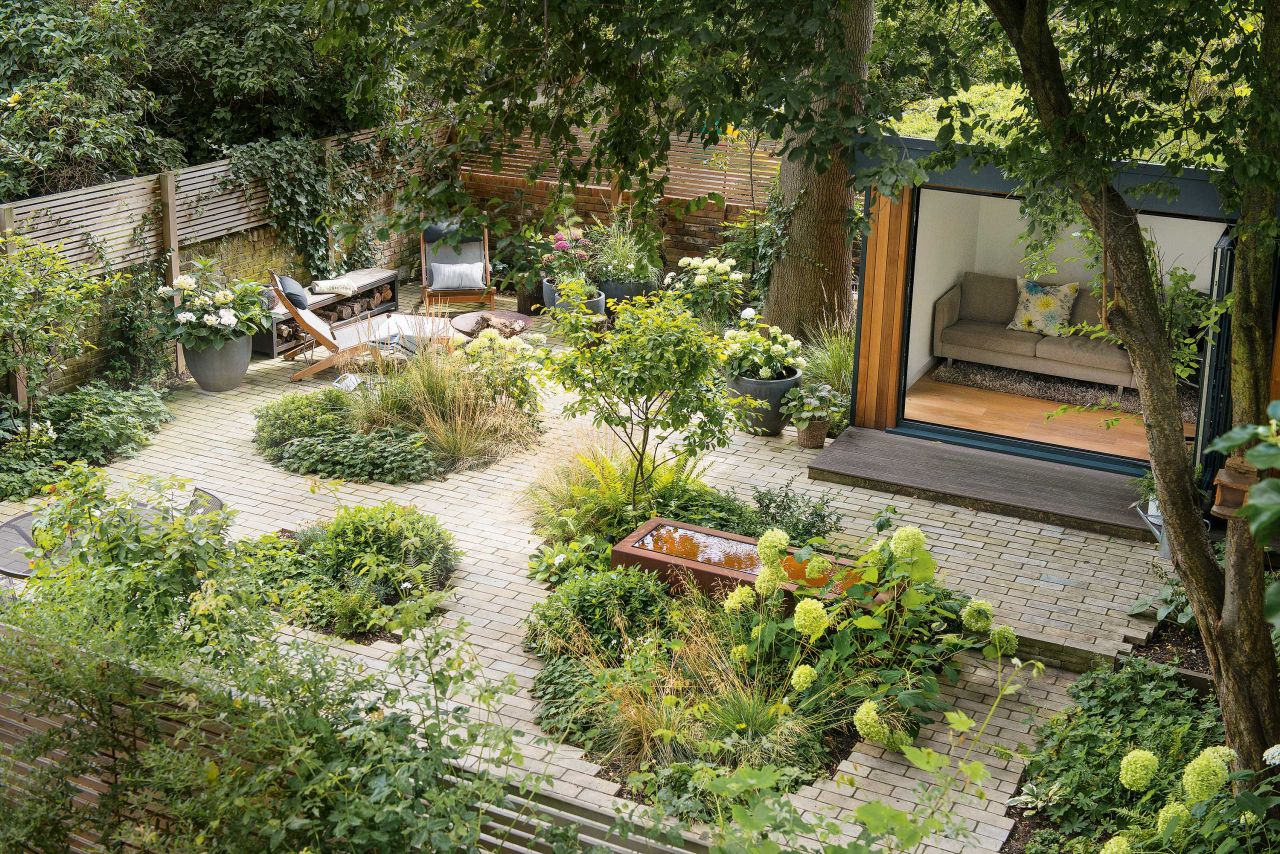 Aside from unfussy plants, investing in comfortable seating is essential in carving out a low-maintenance garden. This way, you can still have space to lounge while adoring your yard landscaping.
Aside from unfussy plants, investing in comfortable seating is essential in carving out a low-maintenance garden. This way, you can still have space to lounge while adoring your yard landscaping.
Bring a comfortable sofa and chairs into your garden and instantly turn it into a nice place to hang out. You can also try to add fun features, such as a hammock or hanging egg chair for extra seats or a quick nap.
6. Easy-Care Garden in an Urban Space
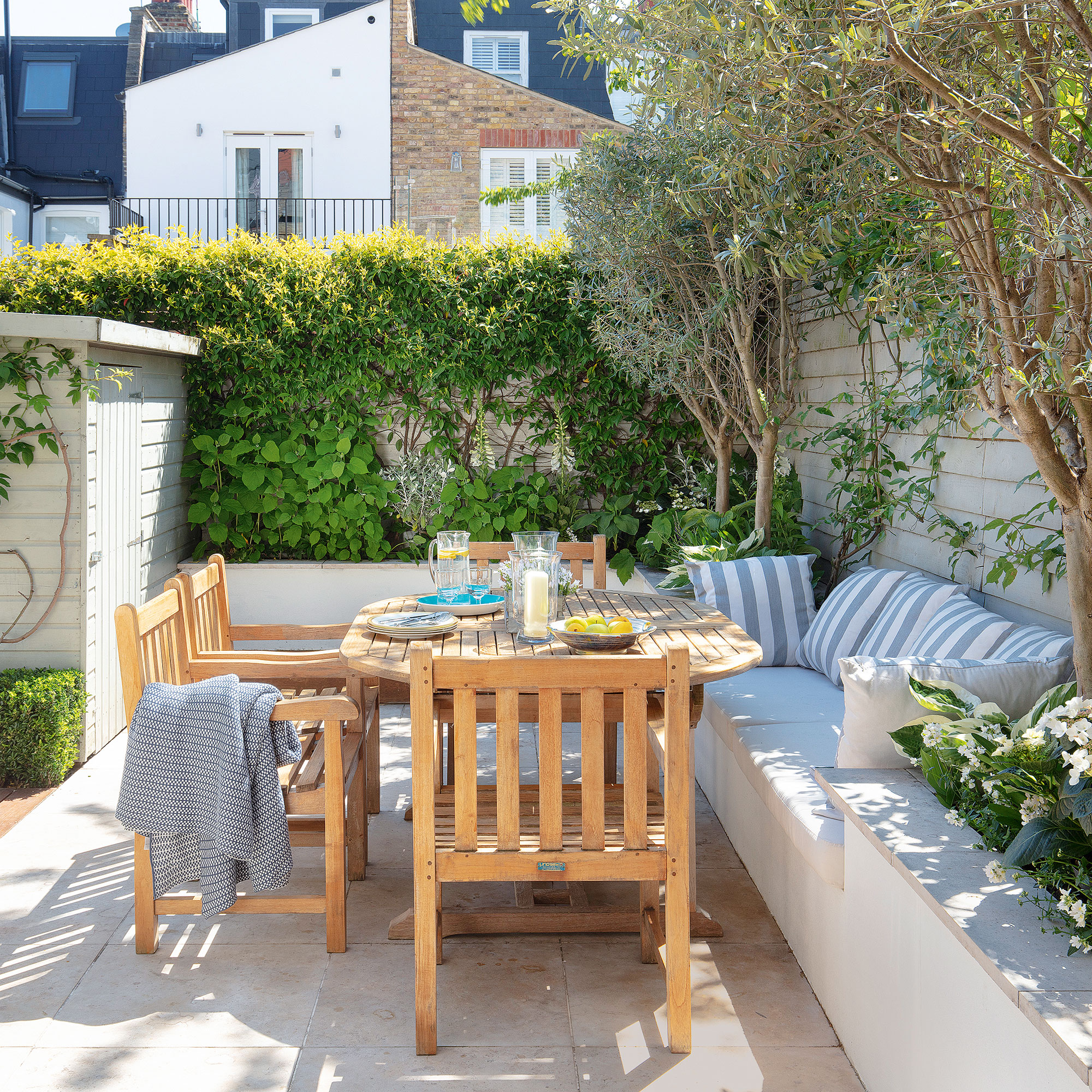
Having a spacious garden in an urban area is pie in the sky. Thus, many people there tend to give up hope of extending their home to the yard and relaxing.
Creating a garden in an urban area is not impossible, though. You can make the most of your space if you arrange things thoughtfully.
This garden, for example, features hard landscaping that creates the best place to hang out. It also has a built-in bench made of concrete. The owner adds wooden chairs and a table that match the deck to enrich the look.
The owner grows boxwood and other low-maintenance plants to round out the look while adding a lively lift.
5. Add More Mulch
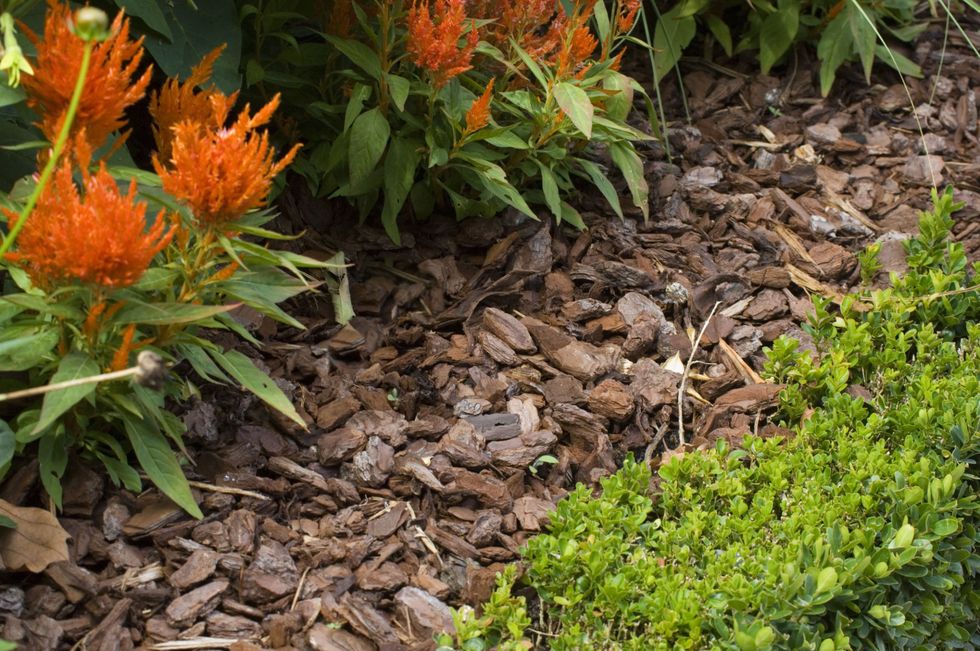 Covering your garden with green grass seems fascinating. However, it entails much work to do. Thus, you need to consider mulch instead.
Covering your garden with green grass seems fascinating. However, it entails much work to do. Thus, you need to consider mulch instead.
Adding more mulch to your garden will give you more time to relax and help your plants thrive well because it can fertilize them.
Another good thing about mulch is it can help you keep weeds at bay, so you do not need to spend more time gardening. Most importantly, it is affordable, and you only need to replace it in spring.
4. Opt for Perennials for Everlasting Beauty
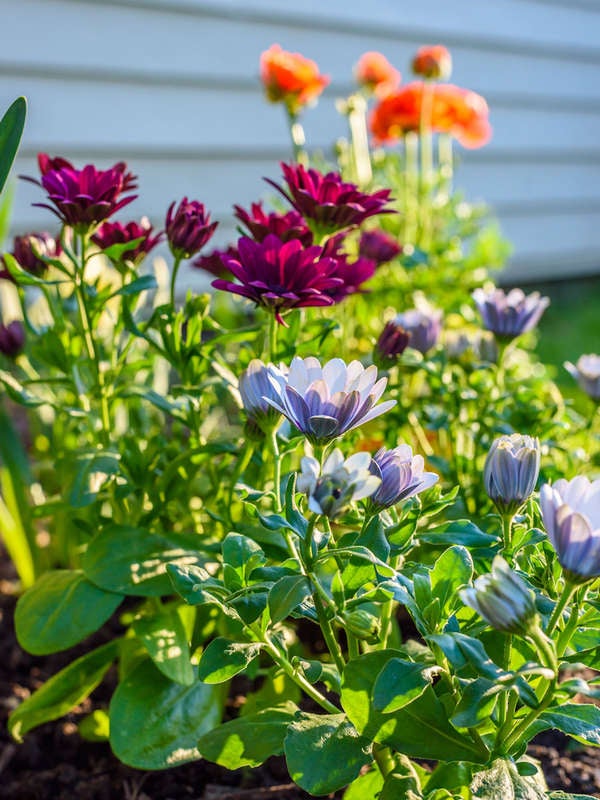 The best thing about perennials is they can grow over and over again – season after season – so that you do not have to plant yearly like what you usually do with annuals. Besides, some perennials are not fussy, which allows a forgetful gardener to stay calm.
The best thing about perennials is they can grow over and over again – season after season – so that you do not have to plant yearly like what you usually do with annuals. Besides, some perennials are not fussy, which allows a forgetful gardener to stay calm.
Pasqueflowers and Penstemon are worth-planting perennials that you need to have in your low-maintenance garden because they are drought-tolerant and durable yet have a delicate look.
3. Go for Gravel rather than Lawn
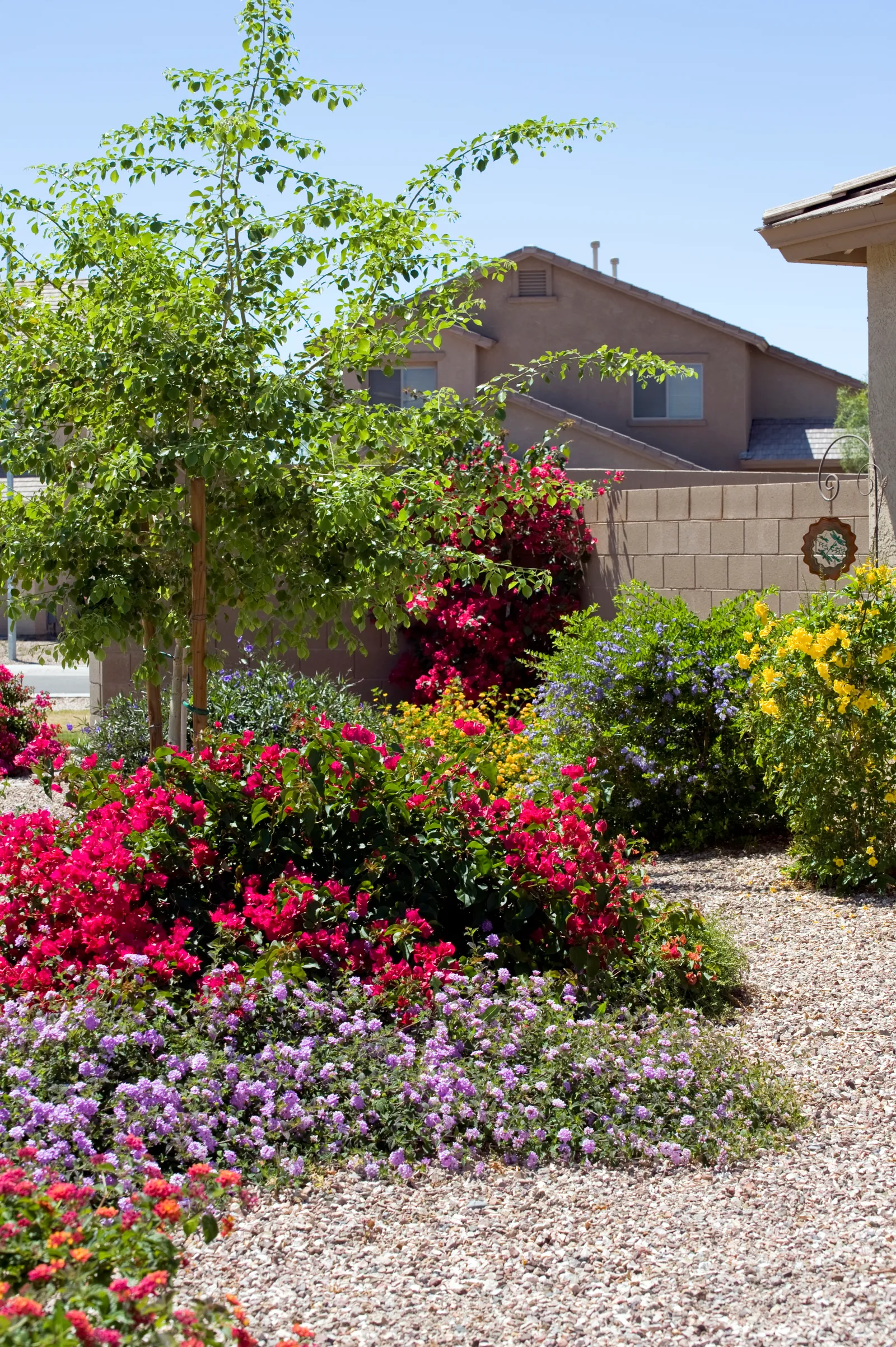 You already realize that a lawn needs mowing and watering regularly, and you do not have time to do that. For this reason, covering your garden with gravel is your greatest bet.
You already realize that a lawn needs mowing and watering regularly, and you do not have time to do that. For this reason, covering your garden with gravel is your greatest bet.
Like pavers, gravel will prevent your footwear from getting muddy. Furthermore, it is the best choice for those who are into Zen garden, which offers tranquility and simplicity.
2. Fake the Lawn
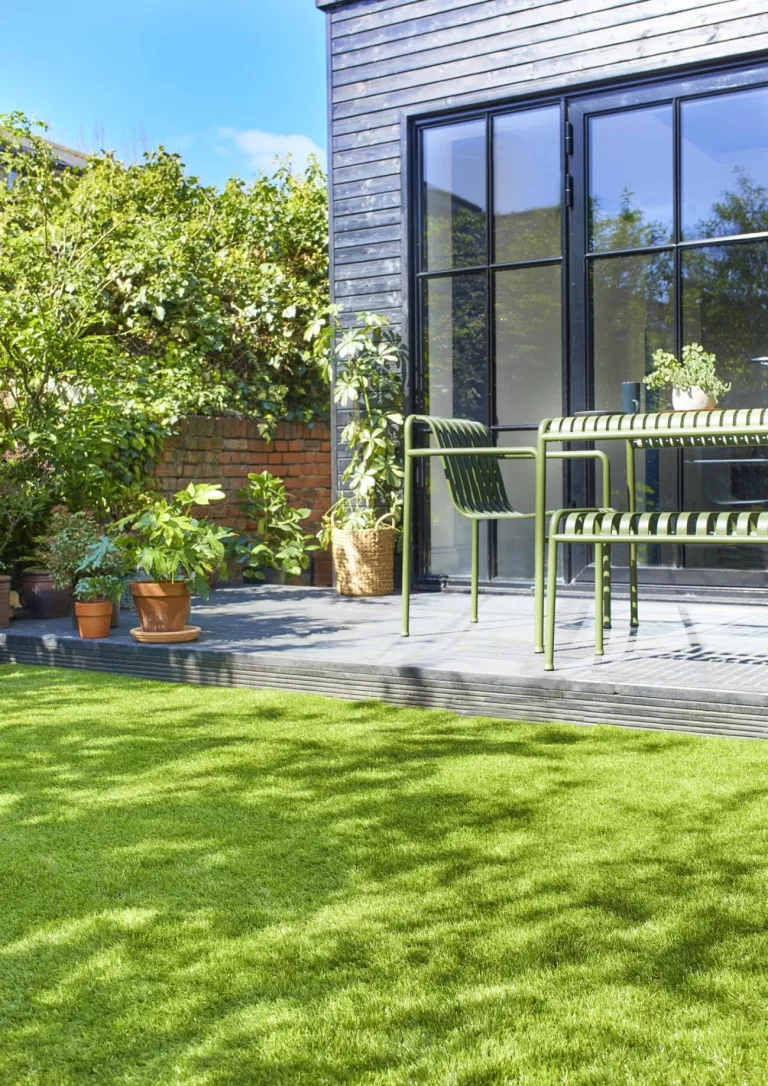 If you want to create a low-maintenance garden but cannot forgo a lawn’s lush, green look, you can invest in artificial turf.
If you want to create a low-maintenance garden but cannot forgo a lawn’s lush, green look, you can invest in artificial turf.
Artificial turf looks precisely the same as natural grass if you glimpse it. However, you will soon notice it is fake when you touch it. Still, it will do in a pinch.
Lastly, Number 1. Incorporate a Water Feature into Your Garden
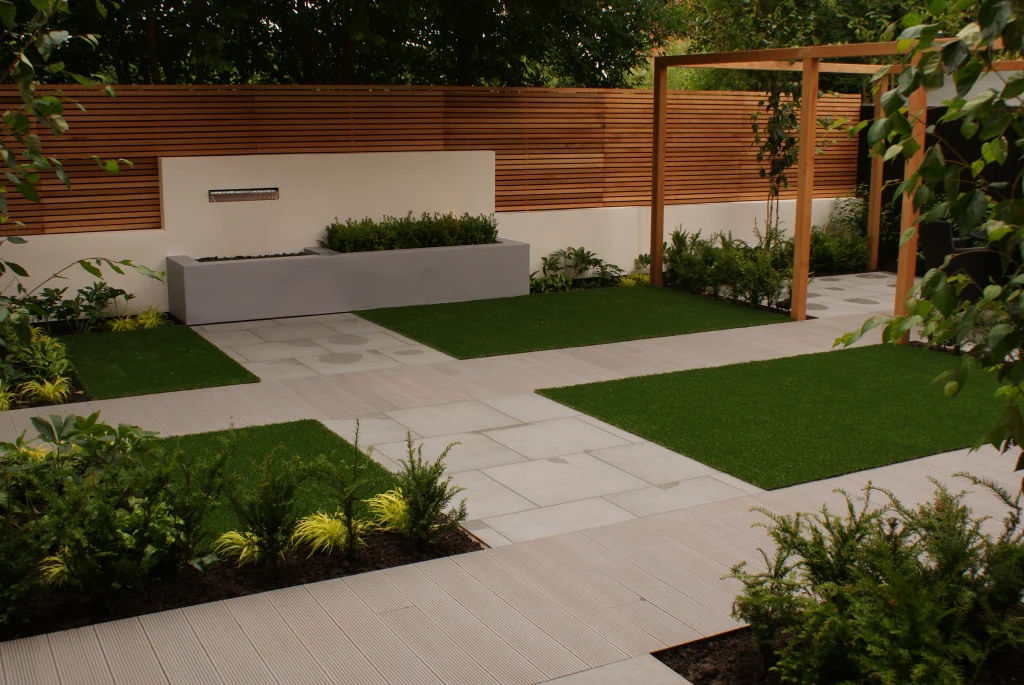 You may think that a water feature can spend much of your time and money. Nothing could be further from the truth.
You may think that a water feature can spend much of your time and money. Nothing could be further from the truth.
Once installed, a water feature does not need much maintenance. Besides, it can be a striking focal point that can awe everyone in your garden. Therefore, it will be worth your money and time.
A striking garden does not always entail beautiful annuals and a regularly mown lawn. These ten low-maintenance garden landscaping ideas have shown you that you can carve out the beauty in your home effortlessly.
References:
10. Housebeautiful.com, Bobvila.com
9. Homify.co.uk
8. Homify.co.uk
7. Housebeautiful.com, Gardeningetc.com
6. Gardeningetc.com, Idealhome
5. Countryliving.com
4. Bobvila.com
3. Architecturaldigest.com
2. Realhomes.com
1. Homify.co.uk